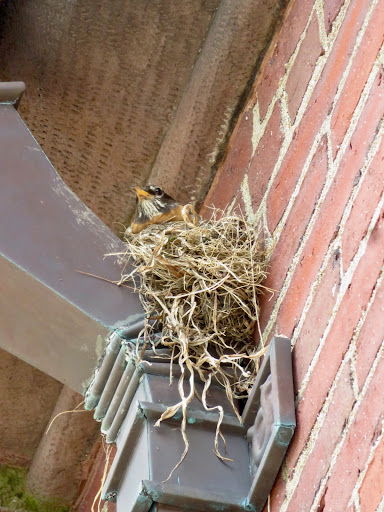As I was watering the library’s tomatoes and fall greens, I spotted a small object just outside the entrance. It was new, and its color stood out from the gray and pink masonry.


A handful of Massachusetts birds lay small, unmarked blue eggs. These include the gray catbird and a variety of thrushes: the eastern bluebird, the wood and hermit thrush, the veery, and the American robin. While field guides, such as Hal Harrison’s A Field Guide to Birds’ Nests, display photos and list measurements, in this case evidence was readily available.
The egg shell was at the base of a drainpipe. Near the top of this pipe, tucked into an angle, is a nest.

On July 14, a library patron alerted staff to the presence of the nest. It is hidden in plain sight, easy to overlook unless one lingers near the door and takes time to look up. Indeed, hundreds of patrons have been walking under it during the past three weeks.
If, at first, this location seems odd, notice that the nest is protected in multiple directions: above, below, behind and on two sides.

Who might nest in the eave of a building: an eastern phoebe? an American robin? a house finch? All three birds live on the library’s grounds. A nearby phoebe had been very vocal during July, but my observations pointed in a different direction. First, there’s the nest construction: a woven cup of grass fortified with mud, though the mud layer is difficult to see from below. Whenever I saw the bird, mostly at dusk, it was flying from the nest towards our neighbor’s pond, perhaps to collect mud. After repeated attempts, I finally got an image of the cautious bird on July 25. Since then, it’s been easier to spot the female at the nest.

The American robin has an incubation period of 12 to 14 days according to Cornell’s All About Birds. By now, its chicks have probably hatched, though I’ve neither seen nor heard them. Given that this species can begin nesting in April, “our” nest is likely a second or even a third brood. Despite all this effort to raise young, few actually survive. Consider these odds: “On average . . . only 40 percent of nests successfully produce young. Only 25 percent of those fledged young survive to November. From that point on, about half of the robins alive in any year will make it to the next.”
Let’s hope that this set of chicks survives the heat wave. If they do, in another two weeks some noisy robin fledglings will take center stage. In the meantime, a quiet but alert parent watches over them.
The next “What Is It!” column will be on Friday, September 2. To participate, email your local nature photo to lrubinacci@amesfreelibrary.org.